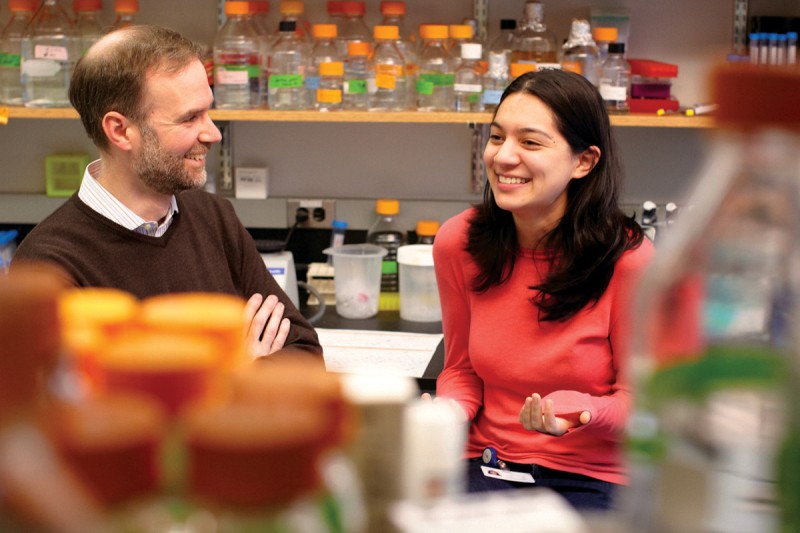
Structural biologist Stephen Long with Alexandria Miller, a graduate student in the Gerstner Sloan Kettering Graduate School of Biomedical Sciences.
Structural biologist Stephen Long and his colleagues use a technique called x-ray crystallography and powerful computer software to build detailed, three-dimensional maps of proteins. Dr. Long recently shared with us how his lab revealed, for the first time, the structure of two proteins found in humans. The findings may guide the development of certain types of drugs in the future.
Proteins are amazing machines. Inside the cells, they act like members of an orchestra, carrying out specific functions at specific times and in regulated ways. And what we do in my laboratory is try to understand how proteins work — primarily by determining what they look like in three dimensions. If you can see something, you can get an idea of how it functions.
My colleagues and I focus primarily on ion channels, proteins that reside within the plasma membrane surrounding cells. The plasma membrane can be likened to a balloon that separates the inside of the cell from the outside, and these channels span the thickness of the balloon.
The plasma membrane is a very thin layer, but it’s incredibly important because it’s what contains the cell, and cells also communicate through it. Membrane proteins — proteins such as ion channels that reside within the membrane — are gatekeepers and relay stations that allow each individual cell to communicate with its neighbors and interact with its environment. In comparison to proteins found within cells, membrane proteins are typically more difficult to study and consequently relatively little is known about their inner workings.
Ion channels act like molecular sieves, only letting their particular ion go in or out of a cell. So a calcium channel is selective for calcium, allowing calcium to pass in and out of a cell but not, for example, sodium or potassium.
Recently, my lab revealed for the first time the three-dimensional structure of two proteins found in humans, one of which — K2P1 — regulates the flow of potassium ions in and out of cells, and the other — called Orai — which regulates the flow of calcium. In both cases we used a technique called x-ray crystallography, which is a method of determining the shape or structure of a protein at an atomic level of detail.
In order to do this, we first produced large amounts of the proteins, then purified and coaxed them to form crystals —solid structures in which all the proteins are symmetrically lined up. A typical crystal would contain approximately a trillion protein molecules. Next, we illuminated the crystals with an intense beam of x-ray light generated by a massive instrument called a synchrotron located at Brookhaven National Laboratories on Long Island. As the x-rays interact with each individual protein molecule within the crystal, the rays are diffracted at different angles. Captured on a screen, the diffracted rays form a unique pattern.
From these patterns we were able to derive detailed information about the unique shapes of K2P1 and Orai. Finally, using a computer, we built an atomic model — an architectural mockup that shows every atom of both proteins. From this work, we obtained the first visualizations of any human potassium channel and of any calcium channel.
By drawing the detailed three-dimensional model of K2P1 and studying this model atom by atom, we and other scientists will be able to come up with ideas about how this channel works and test our ideas in the lab. It’s too early to say with certainty, but I think there are good reasons to be hopeful that our study will guide the development of certain types of drugs in the future.
Orai has been detected in almost every tissue of the body, which underscores the importance of calcium signaling in all sorts of biological processes. We still have much to learn about calcium signaling, but one setting in which we understand it relatively well is in T cells (a type of immune cell). Calcium is an important signaling molecule in these cells, and Orai is essential for the activation of the immune response. As with K2P1, this is very early work, but I hope that what we’ve revealed of the structure of Orai may set the stage for the development of drugs that target this channel and can be used to control the activation of the immune system in the context of autoimmune diseases, allergy, cancer, and other disorders.
In a small way, what we do is like going to the moon for the first time. We were the first people to see what K2P1 and Orai look like, and now we’re telling others. There are very few places besides Memorial Sloan Kettering Cancer Center where I could have done what I’ve done with these projects. The institutional support of basic science has been crucial, the mindset that says, “We want you to try difficult things. We want you to take risks.” Researchers here can commit to trying to answer basic science questions, limited only by their own imaginations. As we have seen time and again, research that seeks to address fundamental biological questions relating to the inner workings of cells can lead, in the long run, to novel therapies for human diseases that wouldn’t have been possible without the commitment to basic science research like that ongoing at the Sloan Kettering Institute.

